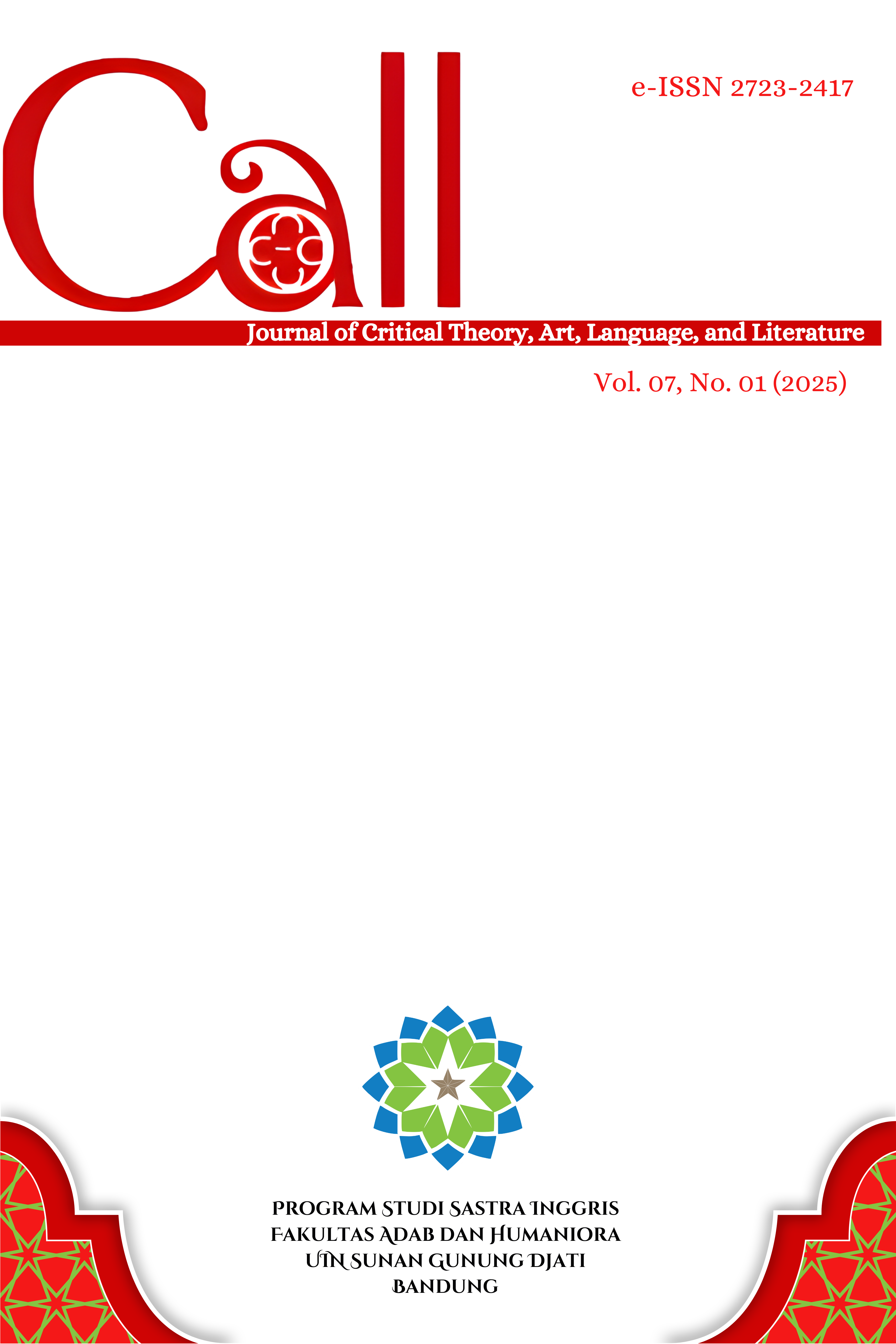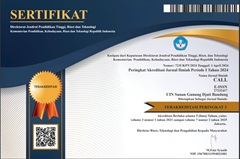CLASSROOM FACTORS AND LANGUAGE LEARNING ANXIETY: 2019-2024 BIBLIOMETRIC REVIEW
DOI:
https://doi.org/10.15575/call.v7i1.41926Keywords:
language learning anxiety, classroom dynamics, bibliometric analysisAbstract
Language learning anxiety has long been recognized as a significant challenge to students’ language acquisition, with classroom dynamics playing a critical role. This study examined how such factors influenced language learning anxiety between 2019 and 2024, with particular attention to the impact of the COVID-19 pandemic. Using bibliometric analysis, the study reviewed over 150 publications to identify key research trends, influential works, and major contributors in the field of language education. The analysis revealed a 40% increase in studies focusing on classroom-related anxiety during the review period and highlighted a growing interest in how technology shapes students’ emotional experiences. Findings indicated that supportive classroom environments, characterized by positive teacher-student interactions and strong peer support, were associated with reduced anxiety. The shift to online and hybrid learning introduced both benefits and challenges: while technology facilitated communication for some students, it increased anxiety for others. Despite growing research attention, studies remained fragmented, often examining classroom factors in isolation rather than as interconnected elements. This review offers valuable insights for educators and policymakers, highlighting the need for holistic strategies that promote inclusive and emotionally supportive learning environments. The findings also lay a foundation for future research aimed at reducing language learning anxiety and improving student outcomes across diverse educational contexts.
References
Alanazi, S., & Bensalem, E. (2024). Modeling the contribution of anxiety, enjoyment, and classroom environment to boredom among students of English as a foreign language. Vigo International Journal of Applied Linguistics, 21.
Alnuzaili, E. S., & Uddin, N. (2020). Dealing with anxiety in foreign language learning classrooms. Journal of Language Teaching and Research, 11 (2), 269–273. DOI: http://dx.doi.org/10.17507/jltr.1102.15
Atifnigar, H. (2024). Teachers’ and students’ roles in reducing foreign language anxiety. European Journal of Contemporary Education and E-Learning, 2 (3), 90–106. https://doi.org/10.59324/ejceel.2024.2(3).08
Botes, E., van der Westhuizen, L., Dewaele, J.-M., MacIntyre, P. D., & Greiff, S. (2022). Validating the Short-Form Foreign Language Classroom Anxiety Scale (S-FLCAS). Applied Linguistics. https://doi.org/10.1093/applin/amac018
Chen, X. (2023). A systematic review of foreign language anxiety. Journal of Education, Humanities and Social Sciences, 22, 90–97. https://drpress.org/ojs/index.php/EHSS/article/view/12292
Diner, L. (2023). Anxiety in speaking Japanese experienced by the department of Japanese language education students of Unnes. Journal of Japanese Language Education and Linguistics, 7 (2), 105–116. https://doi.org/10.18196/jjlel.v7i2.18737
El Shazly, R. (2021). Effects of artificial intelligence on English speaking anxiety and speaking performance: A case study. Expert Systems, 38 (3). https://doi.org/10.1111/exsy.12667
Goshi, M. (2005). Foreign language classroom anxiety: How should the classroom teacher deal with it? Journal of The School of Marine Science and Technology, 3 (2), 61–66.
Hao, Z. A. (2024). The effect of the learning environment on students' anxiety and depression levels. International Conference on Global Politics and Socio-Humanities, 94–101. https://doi.org/10.54254/2753-7048/45/20230286
Horwitz, E. (2001). Language anxiety and achievement. Annual Review of Applied Linguistics, 21. https://doi.org/10.1017/s026719050100007
Horwitz, E. K., Horwitz, M. B., & Cope, J. (1986). Foreign language classroom anxiety. The Modern Language Journal, 70 (2), 125. https://doi.org/10.2307/327317
Huang, Q. (2021). The role of English as a foreign language teachers’ and learners’ emotions and language achievement and success. Frontiers in Psychology, 12, 756853. https://doi.org/10.3389/fpsyg.2021.756853
Inagaki, R., & Nakaya, M. (2022). Relationship between Japanese language anxiety, beliefs about Japanese learning, and Japanese language use in Japanese language classes.European Journal of Educational Research, 11 (3), 1327–1336. https://doi.org/10.12973/eu-jer.11.3.1327
Issah Baako, & Abroampa, W. K. (2023). Research trends on ICT integration in education: A bibliometric analysis. Cogent Education, 10(2), 2281162. https://doi.org/10.1080/2331186X.2023.2281162
Jiang, Y. and Dewaele, Jean-Marc (2019) How unique is the foreign language classroom enjoyment and anxiety of Chinese EFL learners? System 82 , 13-25
Li, C., & Dewaele, J.-M. (2021). How classroom environment and general grit predict foreign language classroom anxiety of Chinese EFL students. Journal for the Psychology of Language Learning, 3(2), 86–98. https://doi.org/10.52598/jpll/3/2/6
Lin, H. C.-K., Chao, C.-J., & Huang, T.-C. (2015). From a perspective on foreign language learning anxiety to develop an affective tutoring system. Educational Communications and Technology, 727–747. https://doi.org/10.1007/s11423-0159385-6
Machida, T. (2010). Foreign language anxiety among intermediate-level university students of Japanese. Annual Conference of the Central Association of Teachers of Japanese, 62–75.
Mahir Pradana, Hanifah Putri Elisa & Syarifuddin Syarifuddin (2023) Discussing ChatGPT in education: A literature review and bibliometric analysis, Cogent Education, 10 (2), 2243134, DOI: 10.1080/2331186X.2023.2243134
Nakao, S., & Reinders, H. (2022). “This is the end.” A case study of a Japanese learner’s experience and regulation of anxiety. Education Sciences, 12(1), 25. https://doi.org/10.3390/educsci12010025
Pawlak, M., Kruk, M., Zawodniak, J., & Pasikowski, S. (2020). Investigating factors responsible for boredom in English classes: The case of advanced learners. System, 102259. https://doi.org/10.1016/j.system.2020.102259
Purwaningrum, E. W., Hamamah, & Degeng, P. D. D. (2020). Japanese language learners’anxiety: Barriers or successful support. Jurnal Budaya FIB UB, 1 (1), 1–9.
Quintos, S. B. (2021). Examining the relationship between foreign language anxiety and students’ learning motivation to Filipino foreign language learners. Information Technology in Industry, 9(1). https://doi.org/10.17762/itii.v9i1.183
Russell, V. (2020). Language anxiety and the online learner. Foreign Language Annals. https://doi.org/10.1111/flan.12461
Sainee Tamphu, Imam Suyitno, Gatut Susanto, Nia Budiana, M. Rais Salim, Nurhikmah & Wilda Purnawati (2024) Building bridges to the future of learning: Exploring artificial intelligence research using R-Studio assisted bibliometrics, Cogent Education, 11 (1), 2417623, DOI: 10.1080/2331186X.2024.2417623
Song, Z. (2024). Foreign language anxiety: A review on definition, causes, effects and implication to foreign language teaching. Journal of Education, Humanities and Social Sciences, 26, 795–799. https://drpress.org/ojs/index.php/EHSS/article/view/17919
Toshiyuki Hasumi & Mei-Shiu Chiu (2024) Technology-enhanced language learning in English language education: Performance analysis, core publications, and emerging trends, Cogent Education, 11 (1), 2346044, DOI: 10.1080/2331186X.2024.234604
Tsang, A. & Dewaele, J. (2024). The relationships between young FL learners’ classroom emotions (anxiety, boredom, & enjoyment), engagement, and FL proficiency. Applied Linguistics Review, 15(5), 2015-2034. https://doi.org/10.1515/applirev-2022-0077
Vusumuzi Maphosa & Mfowabo Maphosa (2023) African Higher Education institution’s response to COVID-19: A bibliometric analysis and visualisation study, Cogent Education, 10:2, 2273002, DOI: 10.1080/2331186X.2023.2273002
White, C. J. (2018). The emotional turn in applied linguistics and TESOL: Significance, challenges, and prospects. In Emotions in second language teaching (pp. 19–34). https://doi.org/10.1007/978-3-319-75438-3_2
Yan Wang, & Kamarul Kabilan, M. (2024). Integrating technology into English learning in higher education: A bibliometric analysis. Cogent Education, 11(1), 2404201. https://doi.org/10.1080/2331186X.2024.2404201
Zaharuddin, A. M., Suparia, F. A. A., & Khamarudin, F. (2023). The correlation between foreign language anxiety and willingness to communicate among students of Arabic as a foreign language. International Journal of Academic Research in Business and Social Sciences, 13(4), 735–754 http://dx.doi.org/10.6007/IJARBSS/v13-i4/16643
Downloads
Published
Issue
Section
Citation Check
License
Copyright (c) 2025 Andini

This work is licensed under a Creative Commons Attribution-ShareAlike 4.0 International License.
Authors who publish in CALL agree to the following terms:
- Authors retain copyright and grant the journal right of first publication with the work simultaneously licensed under Attribution-ShareAlike 4.0 International (CC BY-SA 4.0) License that allows others to share the work with an acknowledgment of the work's authorship and initial publication in this journal.
- Authors are able to enter into separate, additional contractual arrangements for the non-exclusive distribution of the journal's published version of the work (e.g., post it to an institutional repository or publish it in a book), with an acknowledgment of its initial publication in this journal.
- Authors are permitted and encouraged to post their work online (e.g., in institutional repositories or on their website) prior to and during the submission process, as it can lead to productive exchanges, as well as earlier and greater citation of published work (See The Effect of Open Access).




